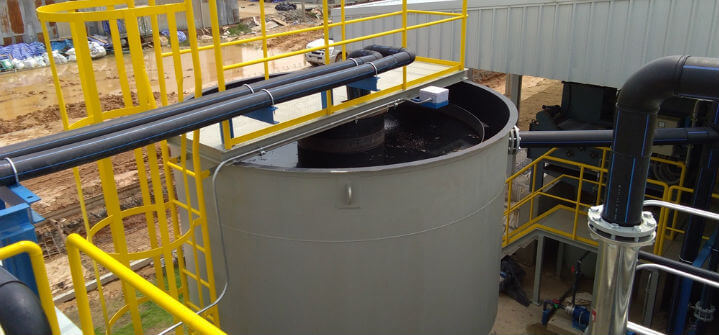What is the Sludge Thickening Process in Water Treatment?
Written by AOS Treatment Solutions on March 6, 2018

What is sludge from water treatment?
Generally, it contains biosolids removed from liquid sewage. Sludge thickening is important because it is the process used in wastewater treatment centers to increase the solids concentration and decrease the free water. This step minimizes the load on the downstream processes, such as sludge dewatering and digestion.
There’s more to this process of course, and this article highlights how sludge thickening works and its general impact, as well as effective groundwater treatment solutions.
How Sludge Thickening Works
There are various processes used in sludge thickening. Each depends on the downstream process, the size of the wastewater plant, and the physical limitations associated with it.
Gravity thickening involves using specially designed circular tanks that concentrate thin sludges to a more-dense sludge product. The limitation of this form of clarification water treatment is that it works mostly for the excess watery sludge derived from an activated-sludge process. Thickening tanks have slow-moving vertical paddles. Sludge flows into the thickening tank, and eventually, it removes excess water from the solids collecting at the bottom. A gravity thickener has a similar process to the tanks, but it has a sloped design so that solids collect at the base.
Dissolved-air flotation is another type of sludge-thickening process. Small air particles attach to the suspended solid material. They enable the solids to break up and float to the surface. These suspended solids have a lower gravity than water when air bubbles attach to them, which makes them float. These particles form a blanket of sludge on the surface that you can remove and treat.
Rotary-drum thickeners are stainless-steel drums with spirals and a flow system used to treat solids. The drum mixes sludge to reduce the water content, leaving a solid concentration behind. Water flows out of the drum for reuse.
Wastewater centrifuge dewatering is another sludge-thickening method suitable for a range of scenarios. They typically require less space than other sludge thickening methods, but generally, they are not effective for primary sedimentation. This method accelerates sedimentation by using centrifugal force.
Why is Sludge Thickening Important?
Sludge thickening is an important process in treating solid waste. It minimizes the water waste, enabling the re-treatment of biosolids so that they can safely circulate back to waterways. It is vital to use the correct product and municipal wastewater treatment solution, so having an expert on hand will give your company the safeguards of dealing with the process in a safe manner.
Failure to thicken sludge in wastewater treatments means that you can unnecessarily waste water. Plus, solids have the potential to re-enter the system, causing pollution. Skipping sludge thickening can and will cause your organization problems if you don’t do it correctly because it creates both health and environmental hazards.
Water treatment consultants can advise you on how to dispose of that solid material correctly. You can recycle solids into fuel products, return them to a landfill, or apply them to the land, depending on the situation. Wastewater experts have a wealth of knowledge in this area, and they can help you dispose of waste solids in the most appropriate way.
When you need to decide the method of sludge thickening for your organization, or if you are looking to dispose of waste safely, contact AOS for help at an early stage in the process. You’ll have the correct advice from experts in groundwater treatment solutions to have safe sludge-thickening methods in operation at your treatment plant.

